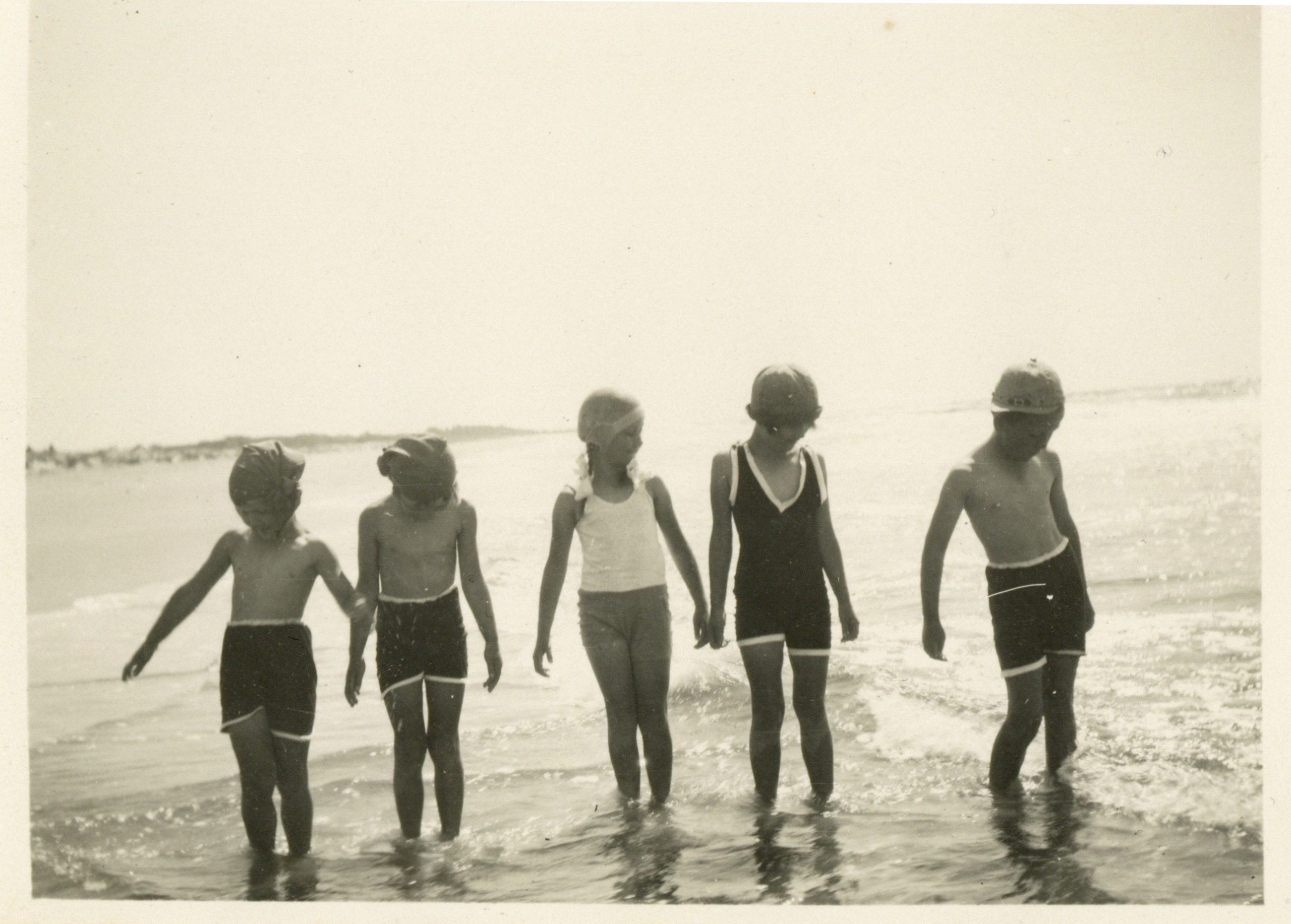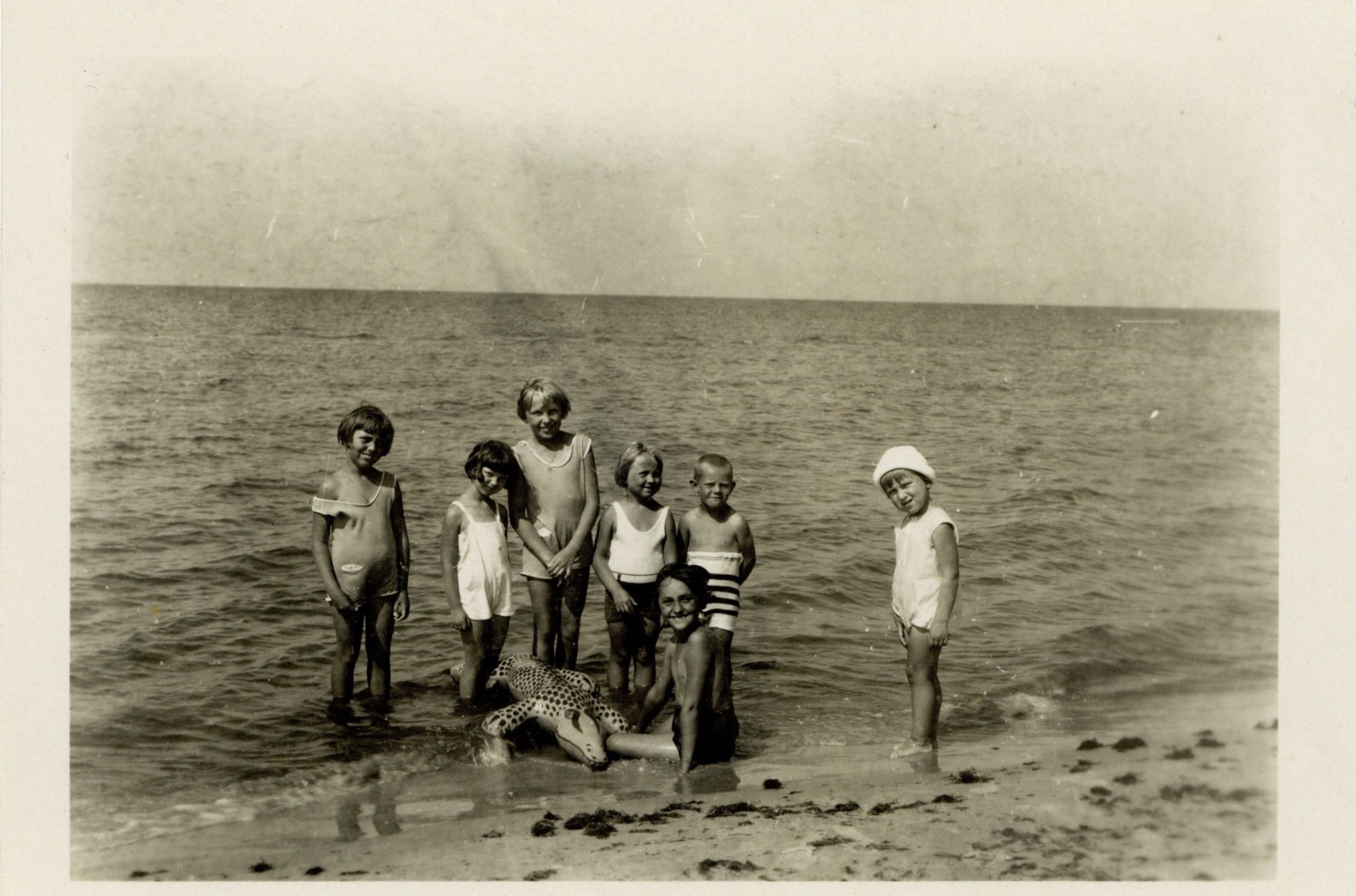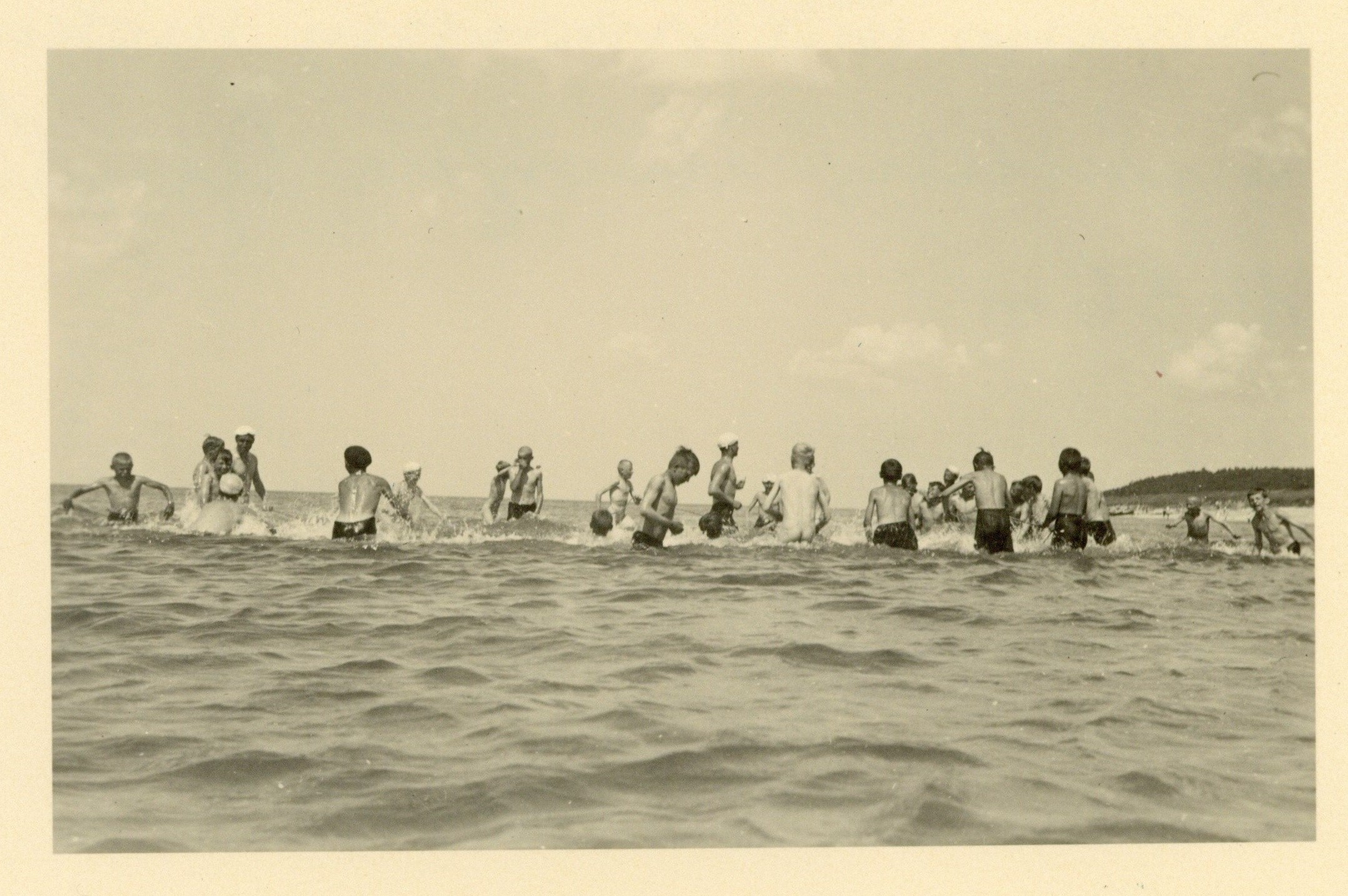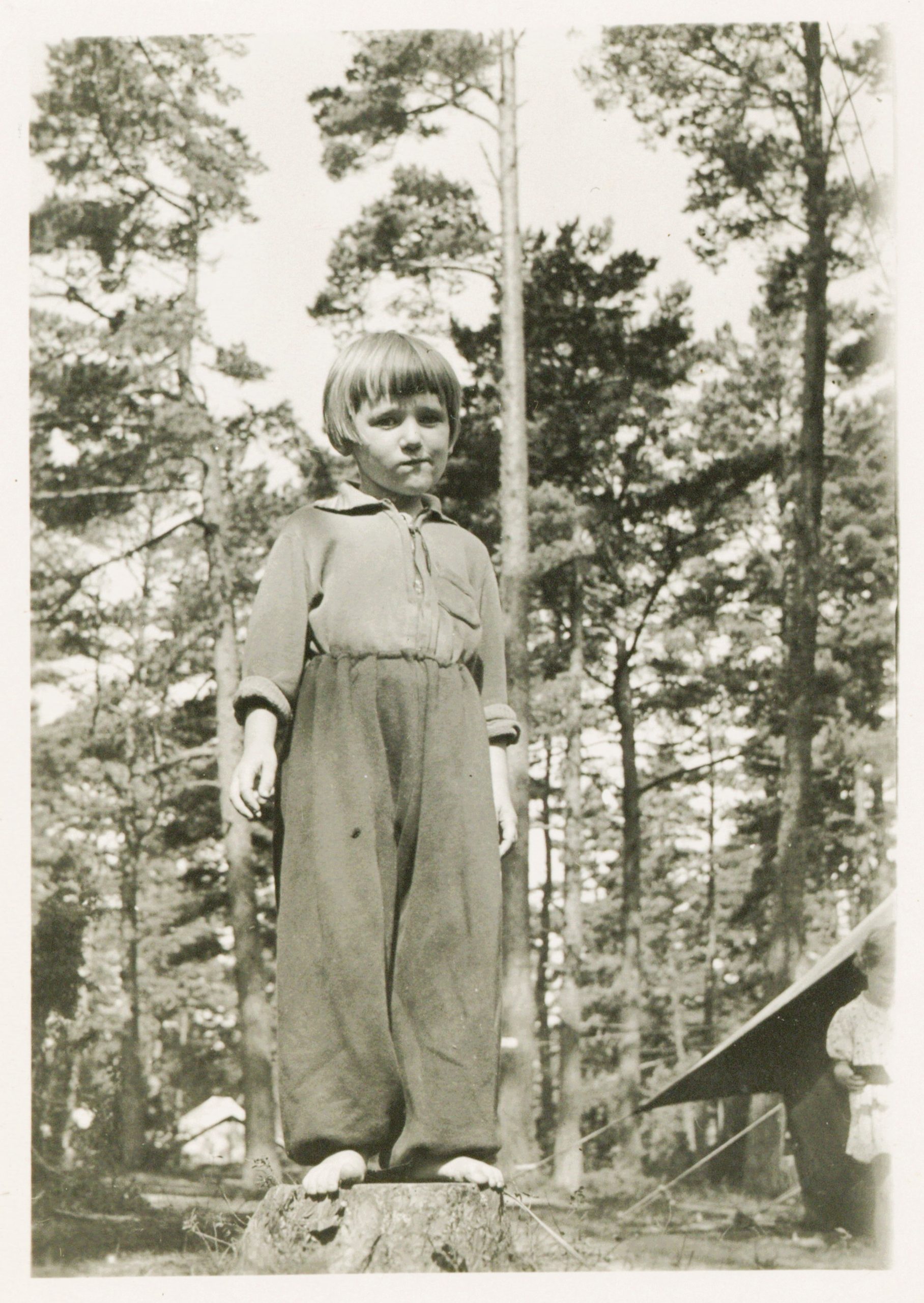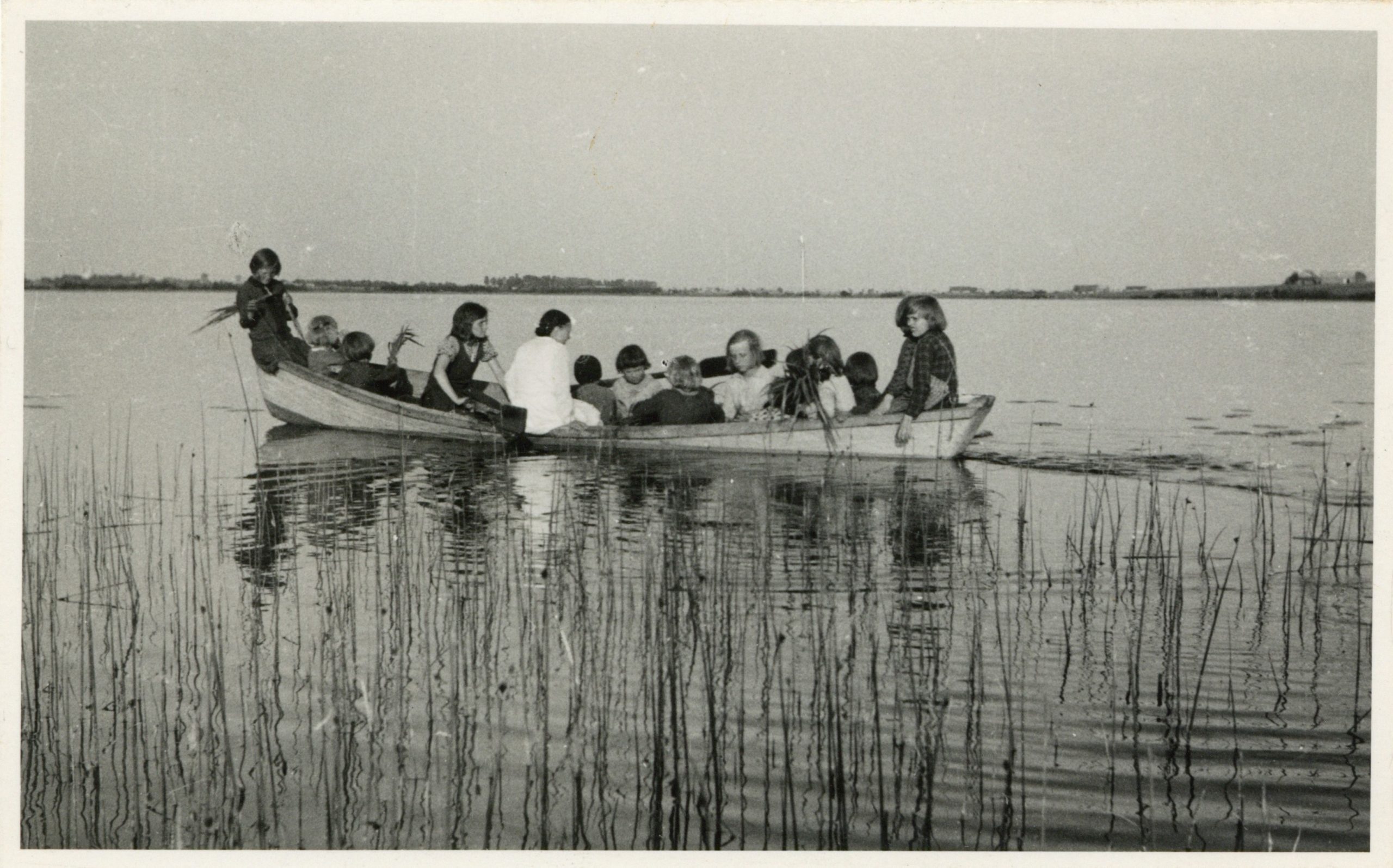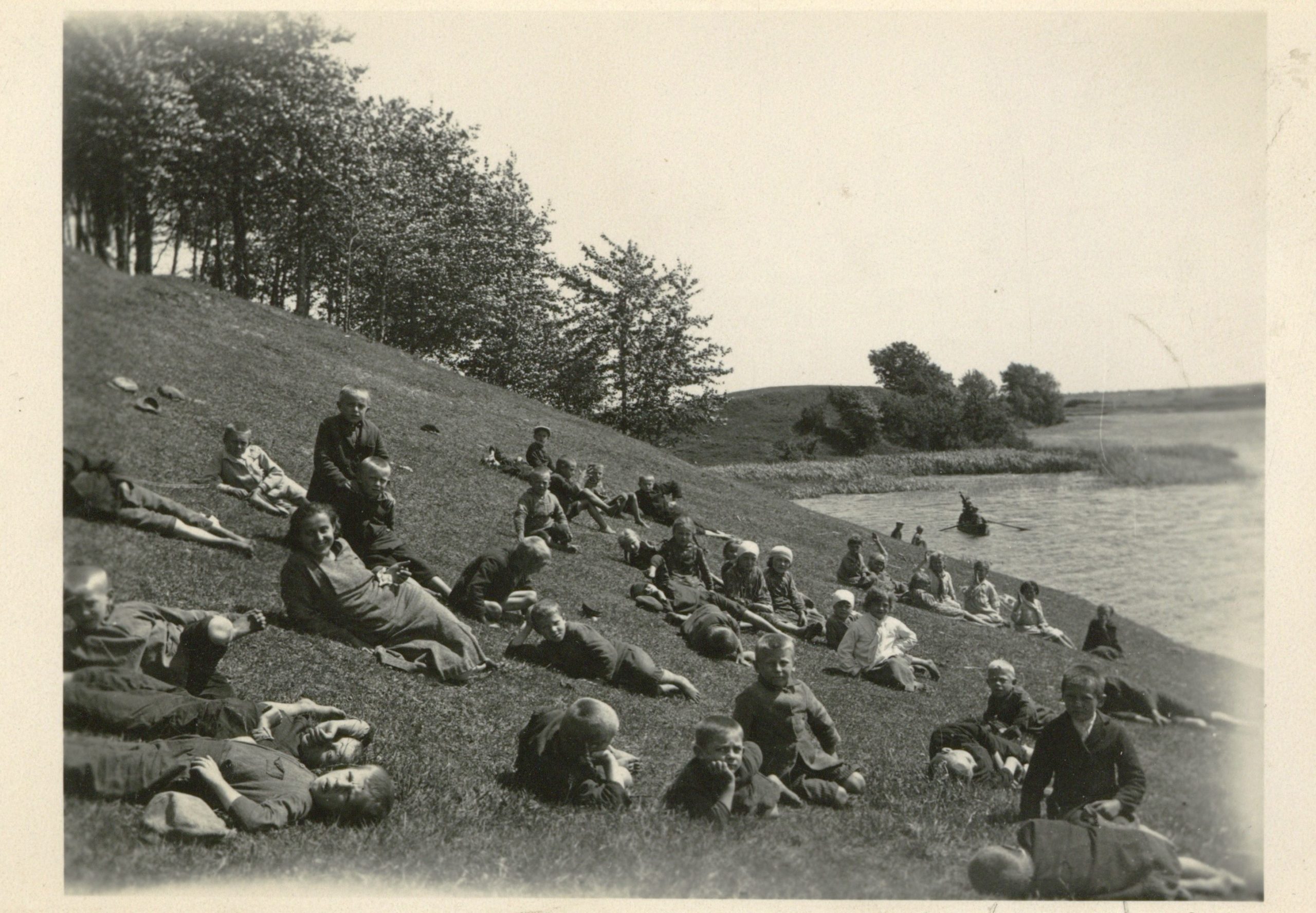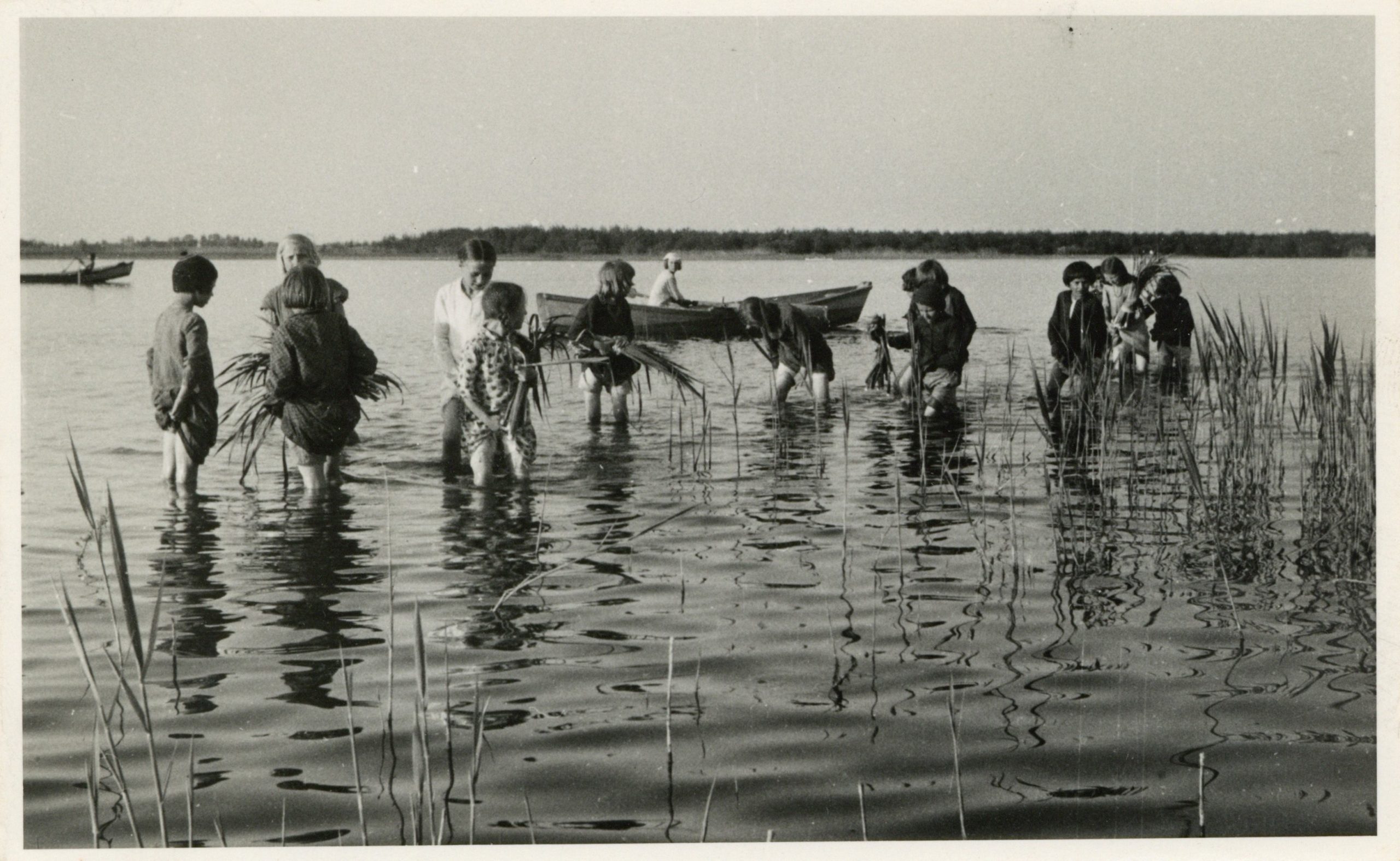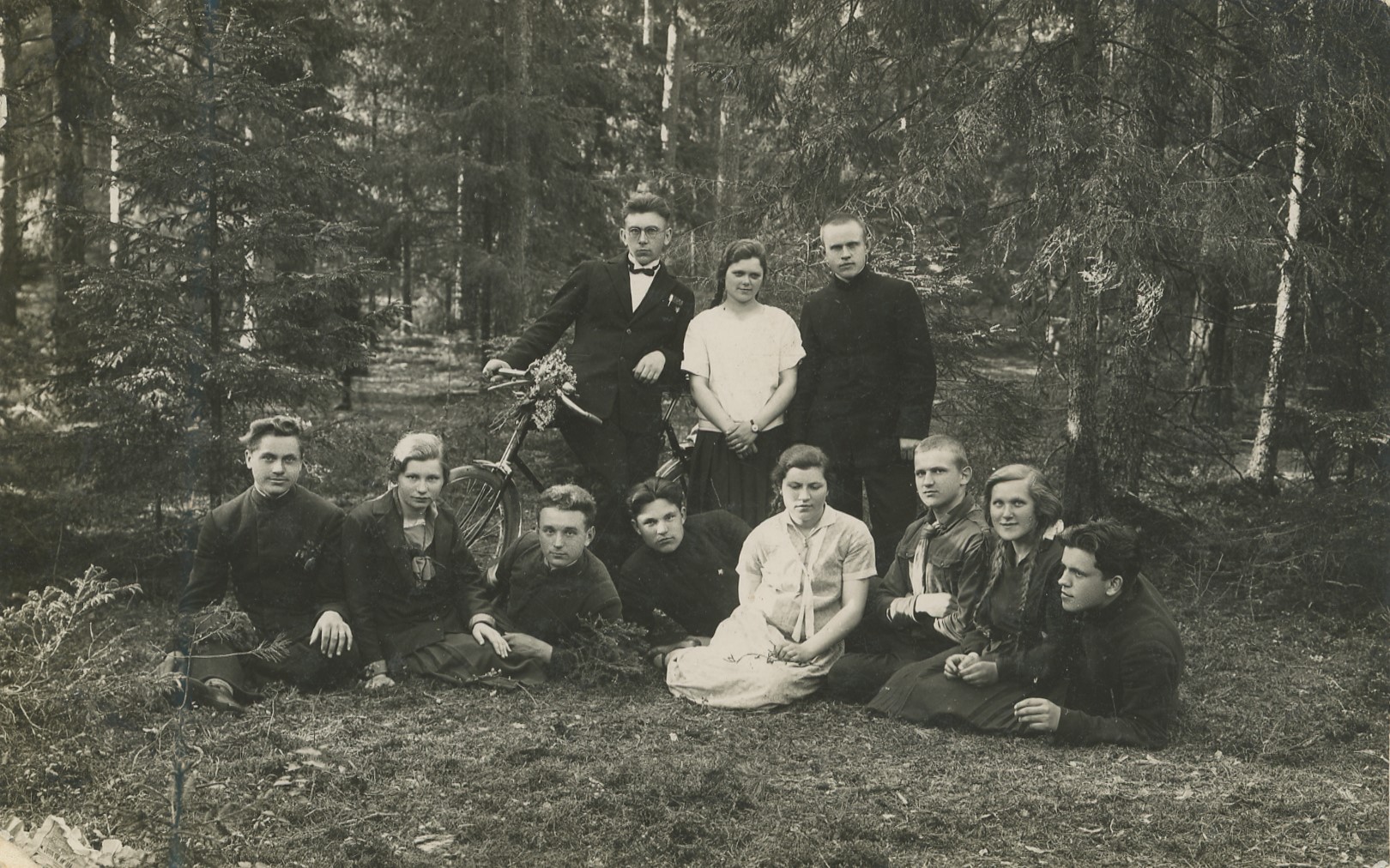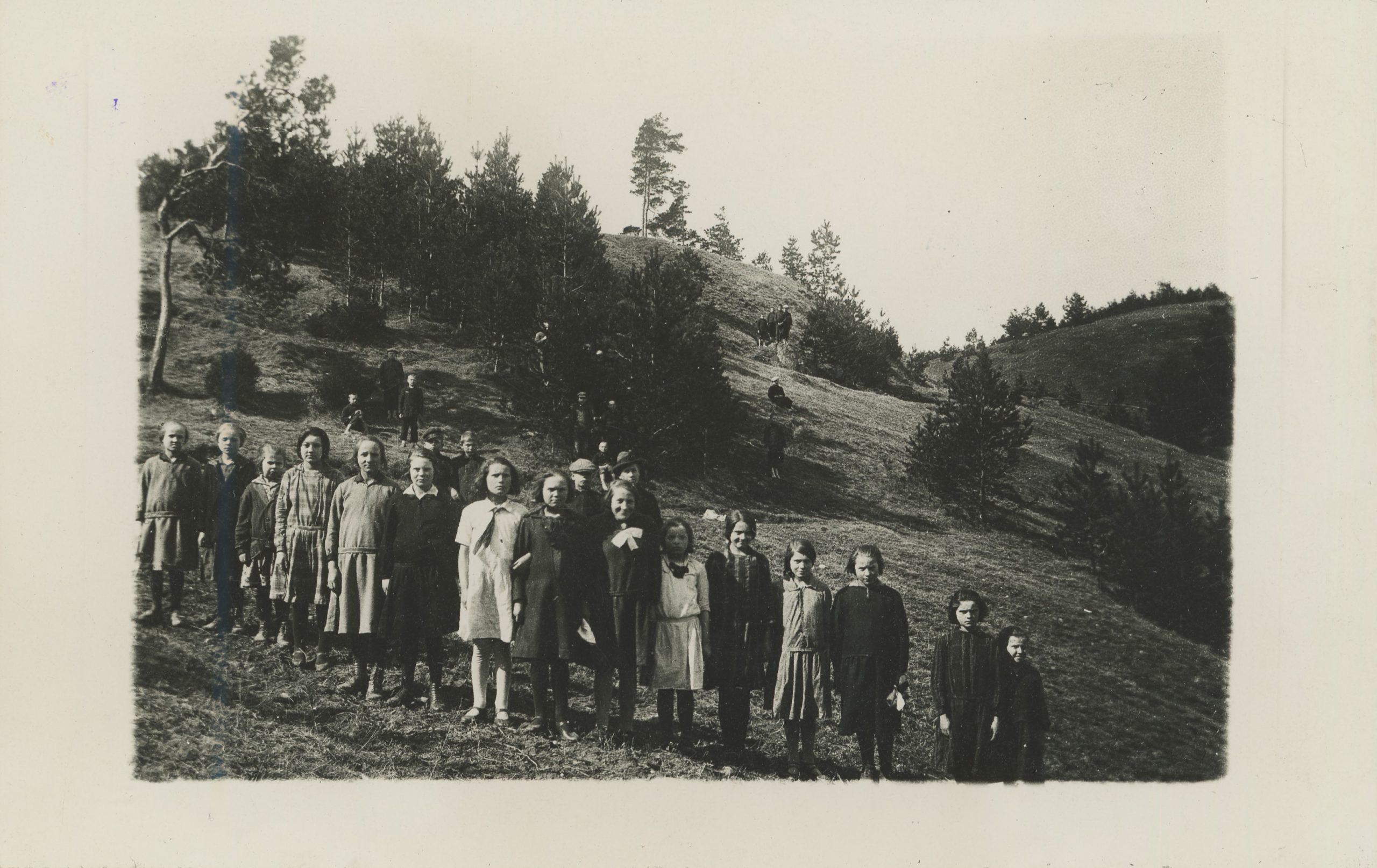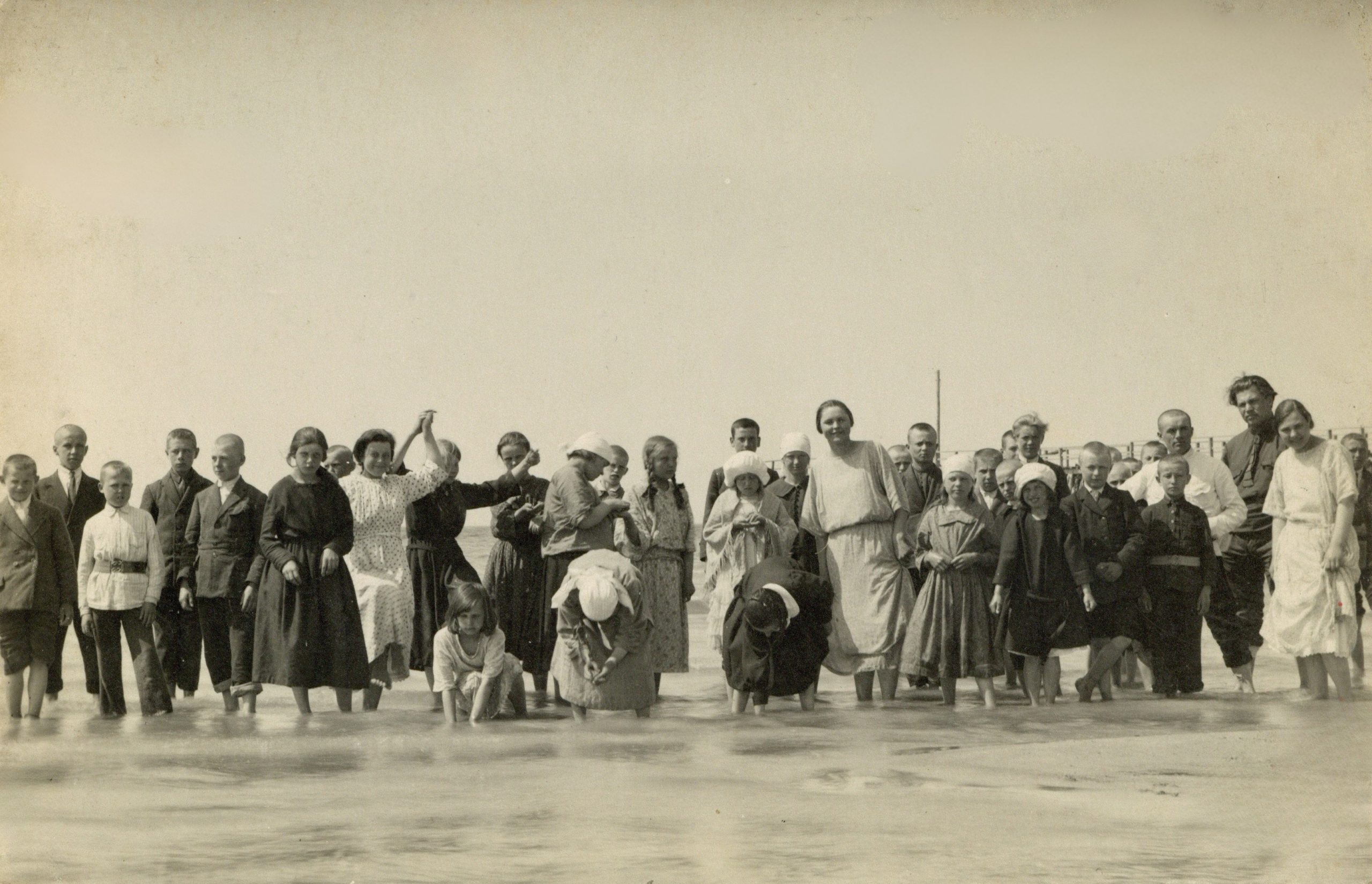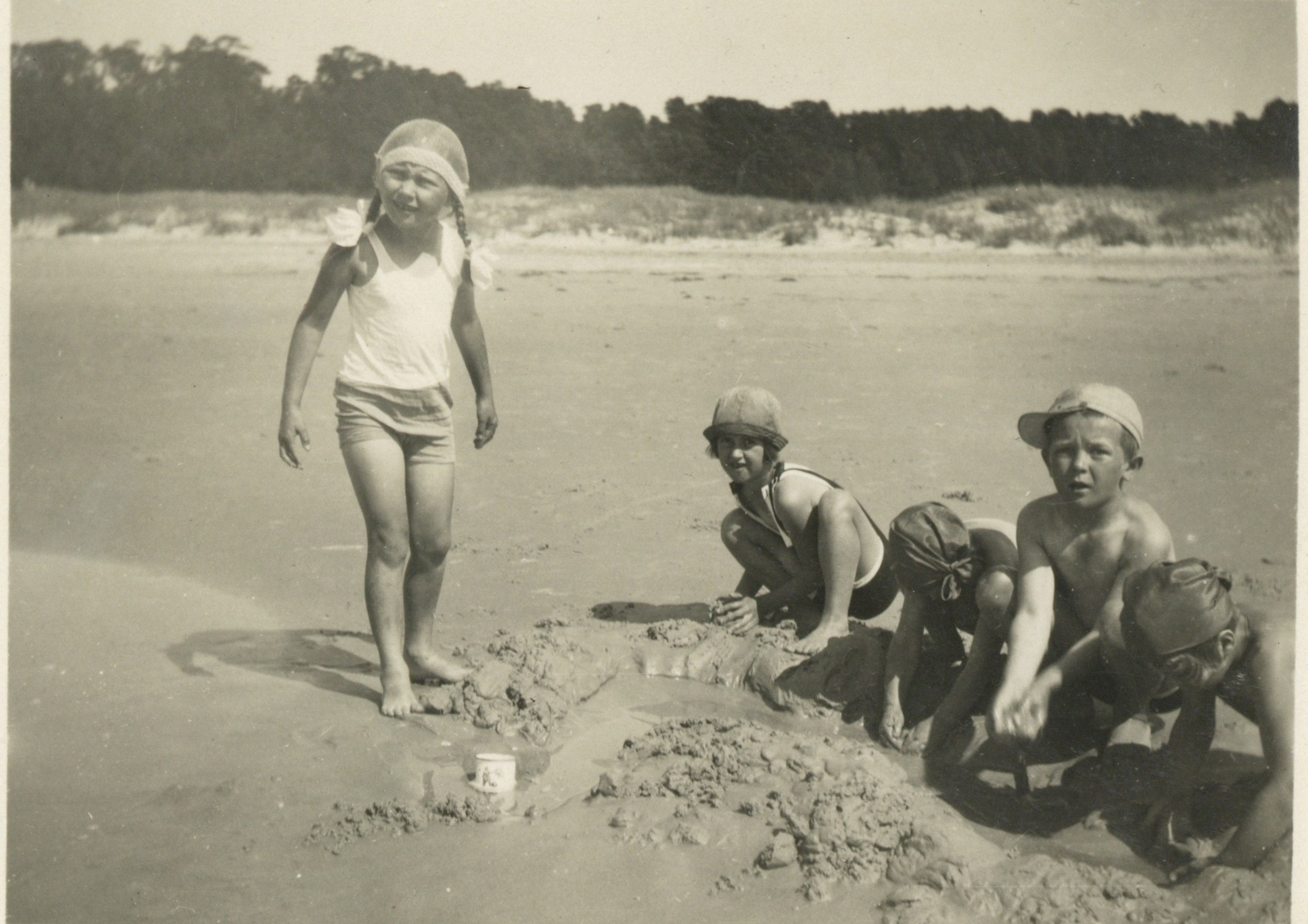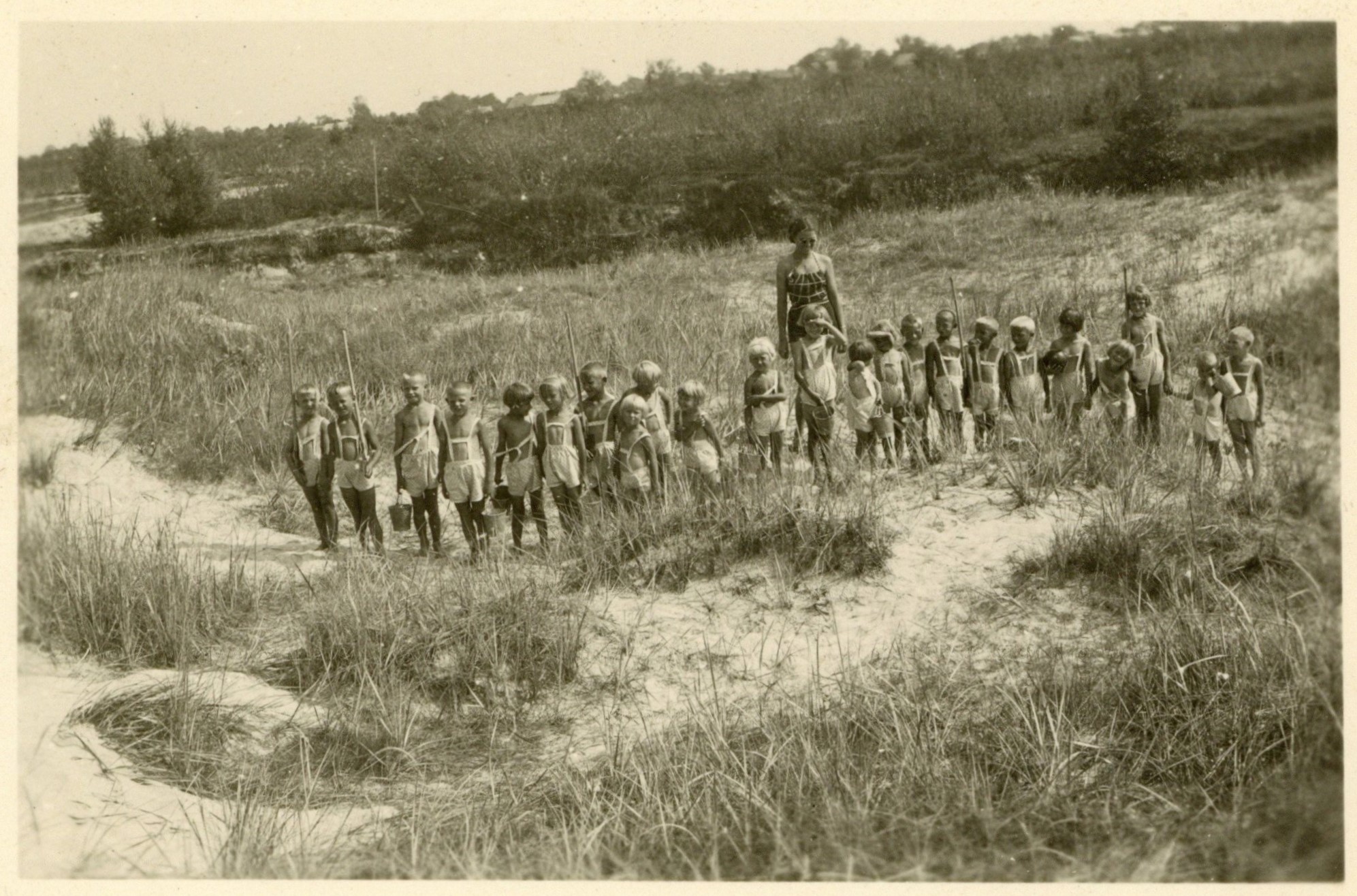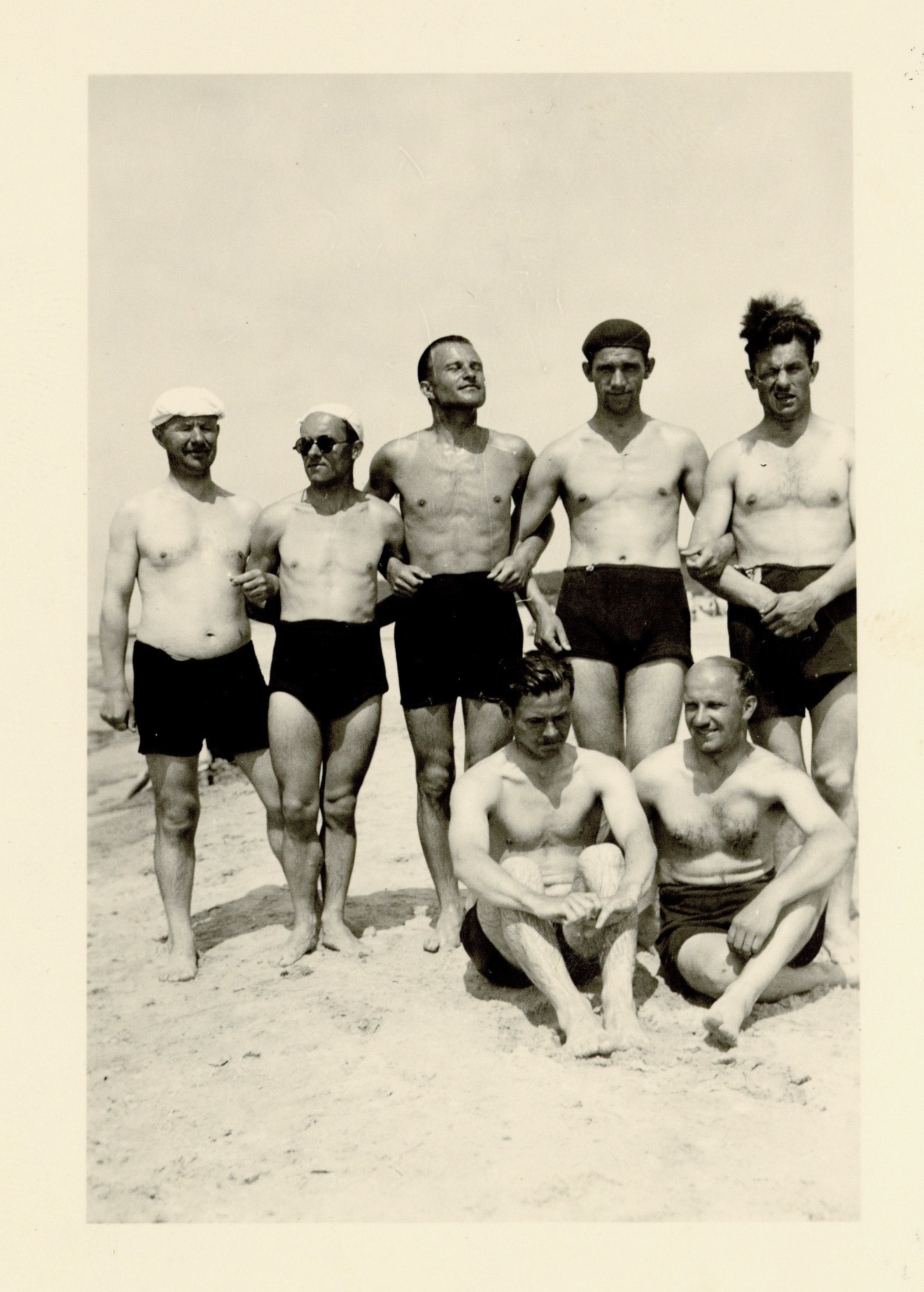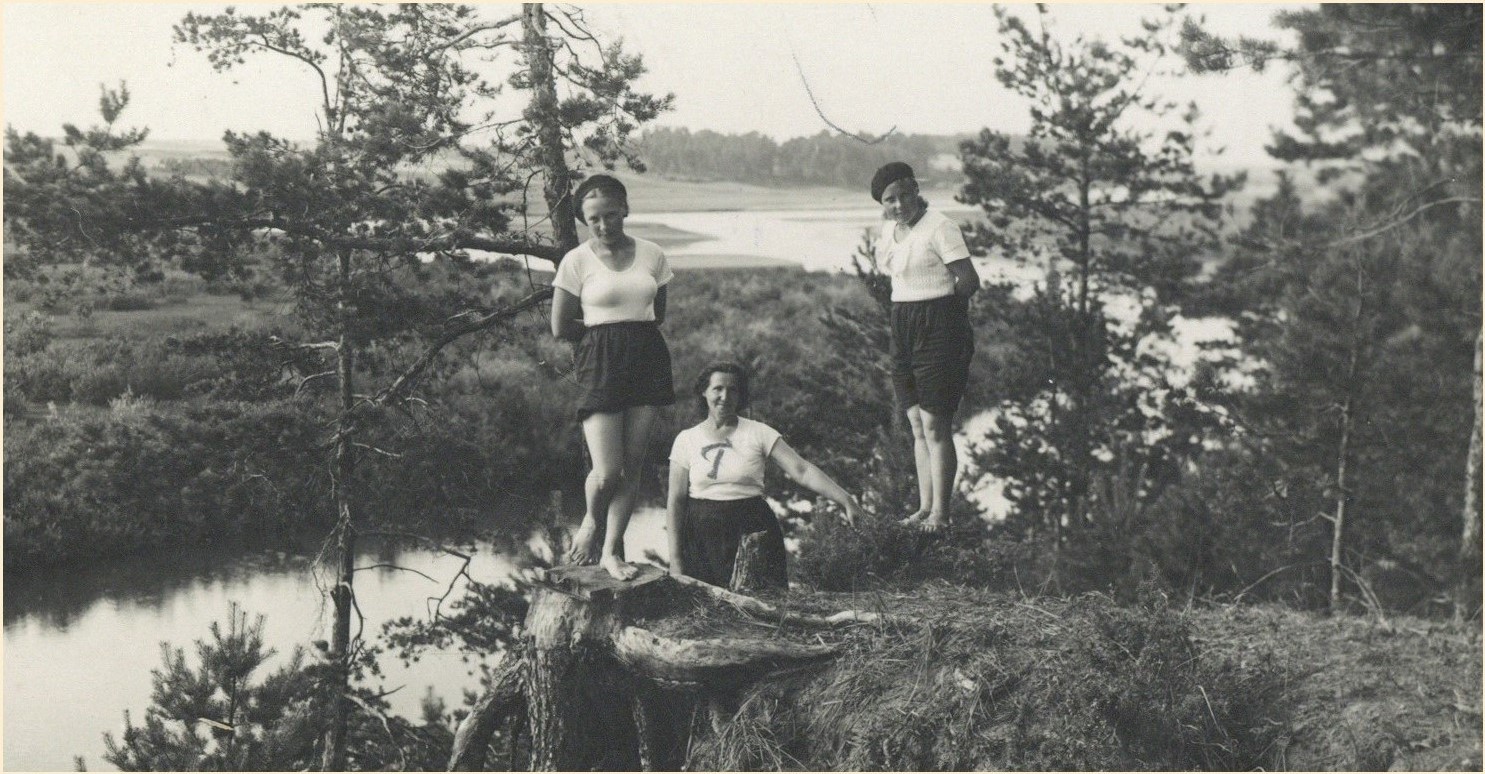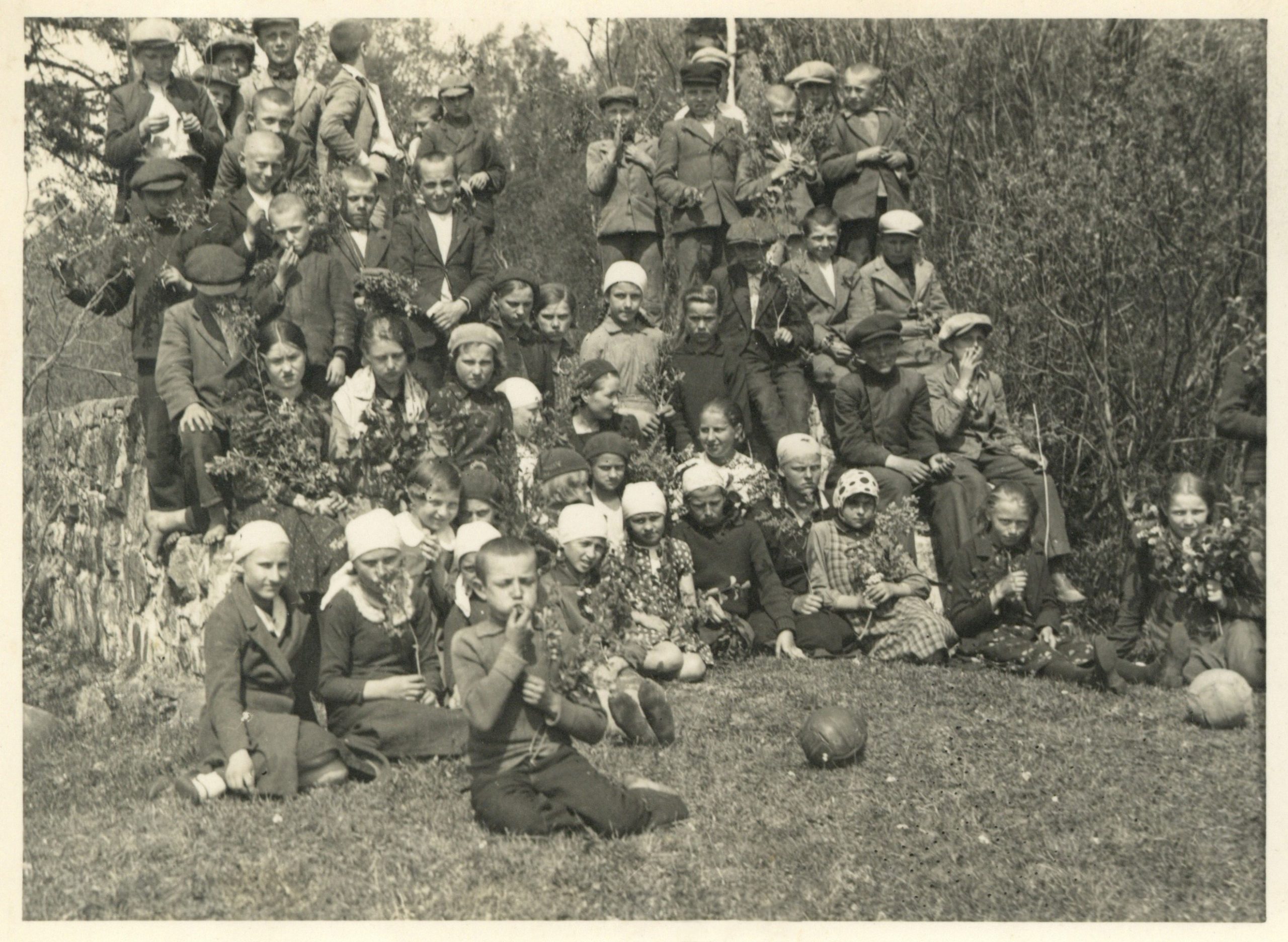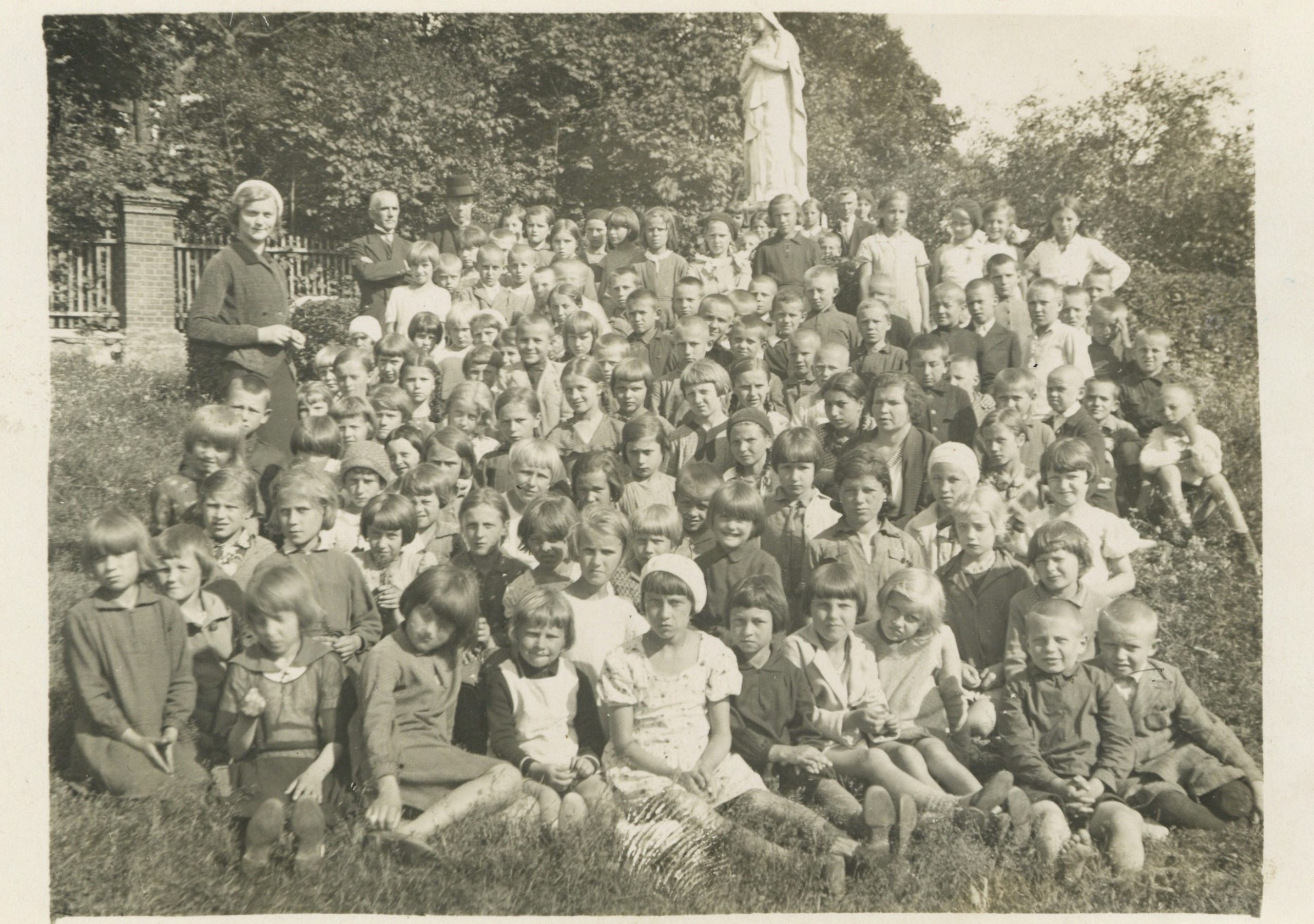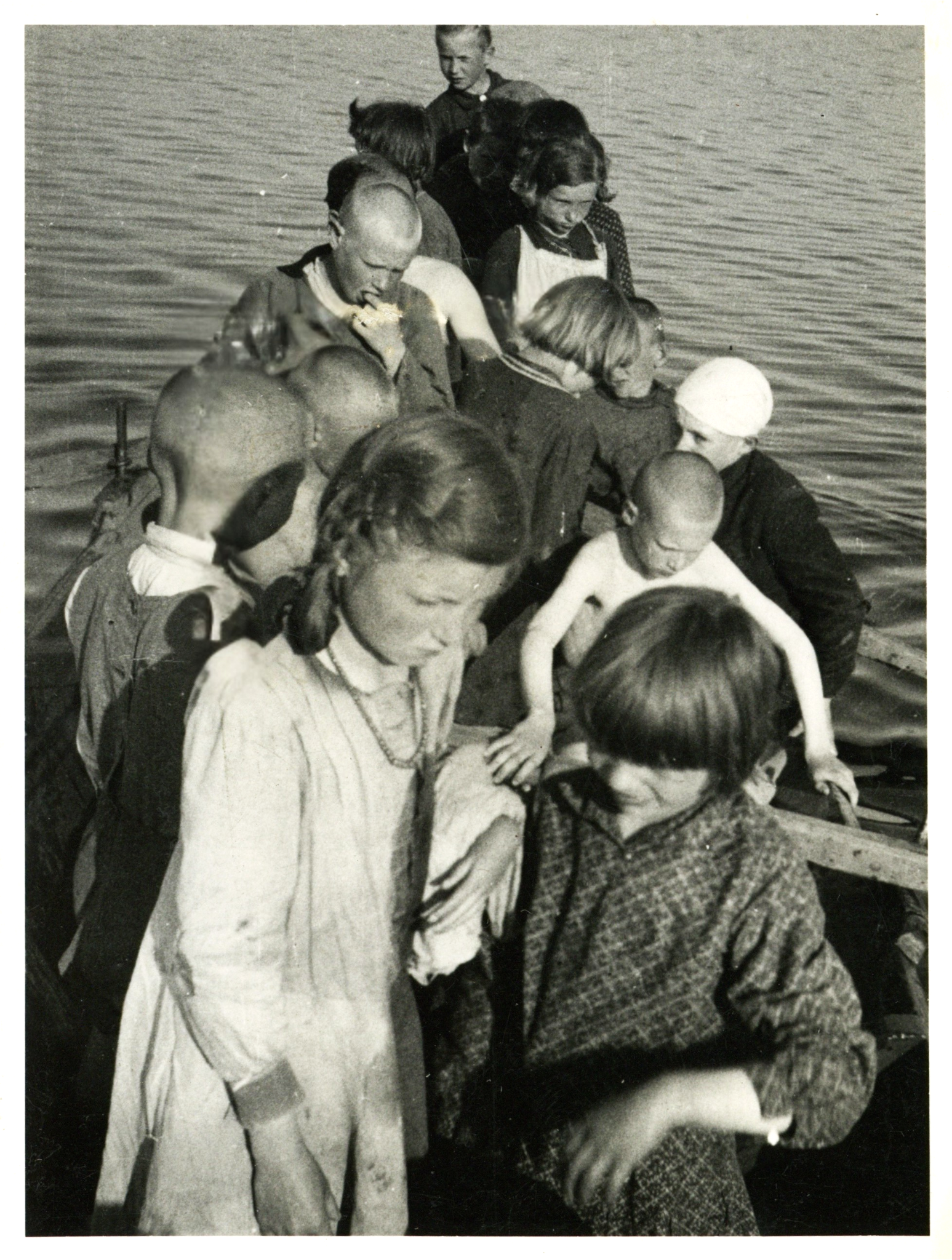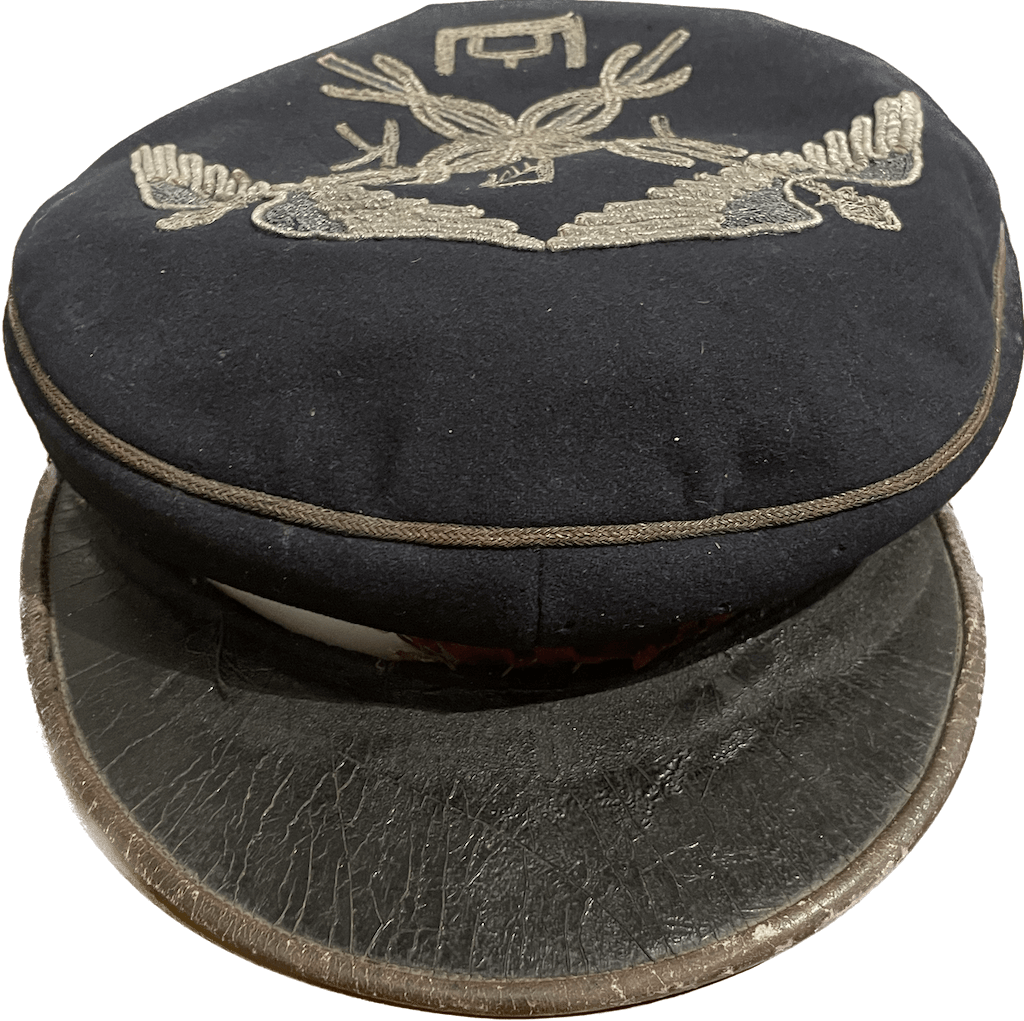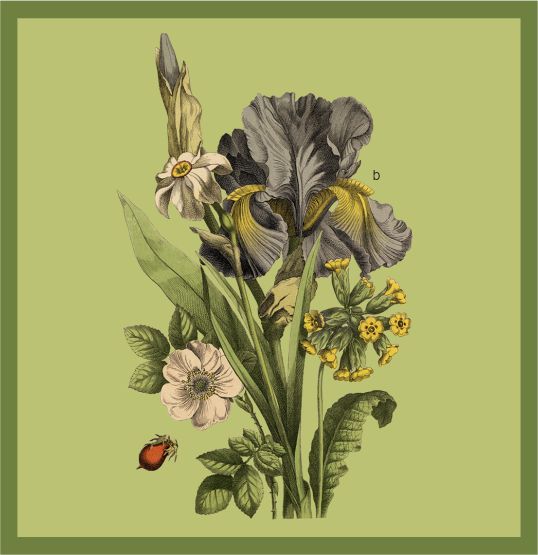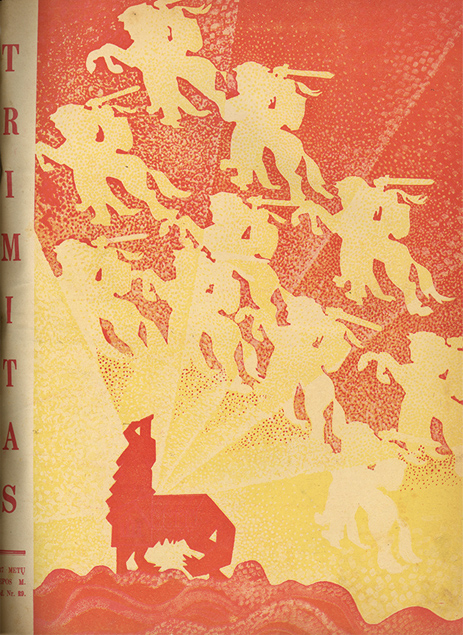In this exhibition, we invite you to take a look at the summer holiday activities of Lithuanian education and educational communities in the interwar period. The photographs in the exhibition will take you back to adventurous hikes and educational excursions, adventurous educational trips in the countryside, and camps filled with relaxation and fun. These activities reflect not only students’ curiosity and the joy of exploration, but also teachers’ efforts to develop students’ independence, citizenship and physical activity. The photographs are a testimony to the active and creative organisation of non-formal education, which moved from the traditional school environment to the sanctuary of nature during the summer.
During the establishment of the education system in interwar Lithuania, special attention was paid to the non-formal education of pupils, especially to local and natural history activities. The Ministry of Education actively promoted the organisation of excursions, trips, hikes and camps by granting concessions for train travel, arranging additional train carriages and sometimes even additional routes.1
At the same time, the students themselves were also talking about improving the quality and accessibility of excursions, raising the idea of setting up an excursion fund. They felt that the accumulation of funds during the autumn and winter months would allow meaningful trips to be organised in the spring and summer without great material difficulties. One of the most active promoters of this idea, J. Vaitkevičius, a pupil of Kalvarija Pro-Gymnasium, wrote in the “Mokslo dienos” publication: “It would be different if excursion funds were set up in every school. Each pupil would have to pay a small weekly fee into these funds, which would already amount to a few litas at the end of the school year. <…> In this way, our scientific youth would visit all the places of our region without great material difficulties. “4 This initiative was also supported by educators and cultural figures, as it promoted a wider involvement of children in cognitive and educational activities.
Taking into account theoretical and practical advice, in the interwar period, almost every educational and training institution organised various educational excursions, trips, picnics, hikes and camps. These activities were an important part of the educational process, and their content was often combined with historical or national accents.
However, the most popular destination for summer holiday excursions and other trips was Lithuanian seaside towns and cities. Nature was a place of relaxation and exploration, where students could directly observe the landscape, vegetation and natural phenomena and consolidate their knowledge of natural history. Such excursions fostered a love for their native land, strengthened the children’s relationship with the environment and fostered responsibility for preserving nature. The latter excursions and camps were characterised by their large scale, bringing together not only large communities from different Lithuanian educational and training institutions, but also schoolchildren from neighbouring countries. This international community is well illustrated by the joint Lithuanian, Latvian and Estonian camps organised in Giruliai since 1936. During the days, the students tested their physical fitness, performed various tasks in nature, and in the evenings, the campers would meet around the campfires to sing folk songs, recite poems, and perform plays. In 1938, for example, the campers took a trip on the boat “President Smetona” and later went on a 20-kilometre hike in the Klaipėda region.5
Lithuania’s rivers and lakes were also highly valued by holidaymakers, and became an important location for school camps. From 15 to 24 June 1934, a school camp was held in the Stalgėnai Forest, near the Minija River, for the Rietavas and Plungė parishes, with about 250 participants. 6 Much attention was paid to the knowledge of the land and nature, with pupils taking part in hikes, making observations, and collecting natural materials.7 The camp programme also included physical education: exercises, national games, and singing Lithuanian folk songs.8
On 4-11 June of the same year, another camp of this kind was set up at the Kęstaičiai lake and pine forest, with the participation of pupils from the Alsėdžiai Primary School.9 The programme of the camp also included environmental studies practice and educational talks.10
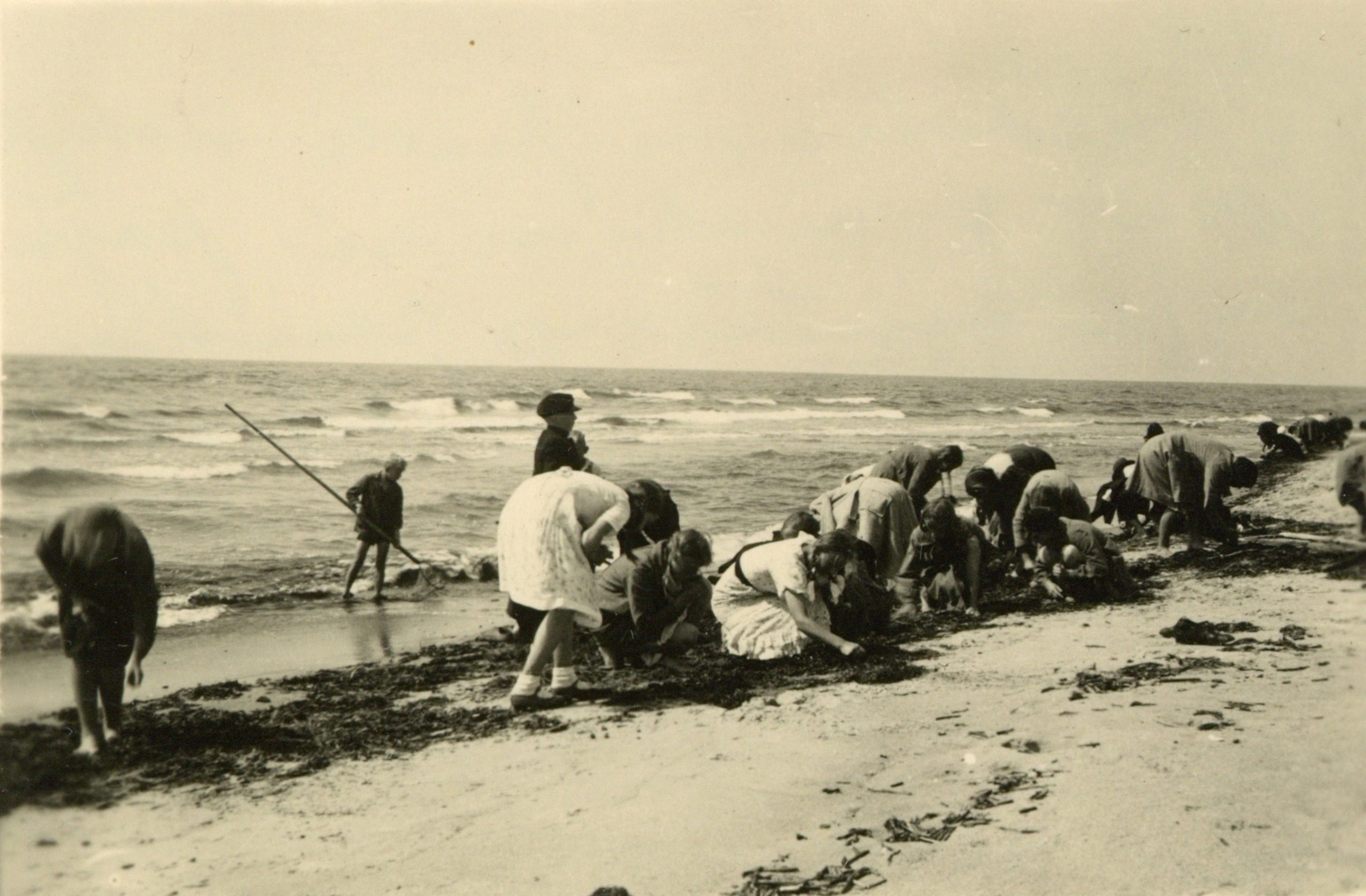
Pupils from Panevėžys City Primary School No.3 collect amber at the seaside. 1937 - Unknown photographer.
In June 1935, a camp for teachers and pupils was established at another lake in the Telšiai district, the Germantas Lake.11 Physical activity classes were led by Karolis Dineika, a prominent promoter of healthy lifestyle, and lectures were given by the educator and social activist Petronėlė Dineikienė, among others.12 The camp was distinguished by the diversity of its content, combining physical activity, national education, and the idea of health promotion.
The camp was notable for the large number of campers.At the end of June 1939, a girls’ and boys’ camp of secondary schools was organised at Alaušas Lake, where more than 1000 students took part.13 The head of the girls’ camp was the headmistress of Šiauliai Girls’ Gymnasium, P. Andziulytė, and the headmistress of the boys was the headmistress of the Biržai Gymnasium Juozas Vosylius.14 The aim of the camp was not only organised camping or hiking, but also the implementation of the sports programme prepared by the Chamber of Physical Education, familiarisation with the basics of topography and military training.15
While most of the summer excursions and trips were organised to Lithuanian resorts and lakes and rivers, cultural and historical excursions to museums and other cultural institutions were equally popular. For example, in the summer of 1927, an excursion to Kaunas was organised for teachers and pupils of the Klaipėda Teachers’ Seminary and the Spartes Gymnasium.16 During the excursion, the pupils visited the War Museum and the museum’s garden.17 In 1932, a similar excursion was organised for the pupils of the primary schools of the Zarasai district.18 During the excursion, the pupils visited the Nature Research Station, the War Museum, Kaunas Castle, Kaunas City Museum, and other notable buildings and workshops.19
Kai kurios vasaros atostogų veiklos buvo skirtos reikšmingoms istorinėms sukaktims paminėti. Pavyzdžiui, 1938 m., minint Lietuvos nepriklausomybės paskelbimo dvidešimtmetį, apskrities mokyklų inspektorius J. Valantinas suorganizavo Kauno miesto pradžios mokyklų ekskursiją į Lietuvos vakarus – pajūrį.20 Apie šią išvyką plačiai rašyta ir to meto spaudoje: „<…> Š. m. birželio mėn. 20 dieną anksti rytą iš Kauno prieplaukos, vadovaujant J. Valantinui, išplaukė du didžiuliai garlaiviai ekskursantų, pakeliui apsistodami Nemuno prieplaukose ir paimdami savo rajono mokinius. <…> Ekskursijoje dalyvavo 617 mokinių ir 67 mokytojai.“21
Thus, the variety of summer holiday activities in the communities of interwar Lithuania’s education and educational institutions testifies that education at that time was not limited to formal classroom teaching – the aim was to develop a fully educated, patriotic, civic and responsible personality. The various thematic excursions, hikes, and camps organised in nature not only broadened pupils’ horizons, but also promoted independence and a sense of community.
Footnotes:
1 For school trips. In: Educational Work, No. 6-7, 1920, p. 77.
2 Vl. V. Saudargienė. Excursions. In: Tautos mokykla, No. 12, 1939, p. 279.
3 Ibid.
4 J. Vaitkevičius. Let’s create excursion funds. In: Mokslo dienos, No. 12, 1938, p. 672.
5 K. Tymukas. Camp on the Amber Coast. In: Mokslo dienos, No. 7-8, 1938, pp. 414-415.
6 A school camp is being prepared. In: Tautos mokykla, No. 7, 1934, p. 139.
7 Ibid.
8 Ibid.
9 Alsėdžiai school camp. In: Tautos mokykla, No. 11, 1934, p. 220.
10 Ibid.
11 Teachers’ and pupils’ camp at Germont. In: Žemaičių prietelius, No. 25, 1935, p. 4.
12 Ibid.
13 Student camps. In: Tautos mokykla, No. 13, 1939, p. 310.
14 Ibid.
15 Ibid.
16 Klaipėda Excursion. In: Lietuvos žinios, No. 145, 1927, p. 3.
17 Ibid.
18 Big excursion of students. In: Lietuvos žinios, No. 135, 1932, p. 6.
19 Ibid.
20 Žekonytė, Kazė. Let’s travel with our little ones. In: Tautos mokykla, No. 13-14, 1938, p. 340.
21 Ibid., 341.
List of sources:
1. 1. In: Tautos mokykla, No. 11, 1934, p. 220.
2. 2. In: Lietuvos žinios, No. 135, 1932, p. 6.
3. Concerning pupils’ excursions. In: Educational Work, 6-7, 1920, p. 77.
4. Vaitkevičius. Let us create excursion funds. In: Mokslo dienos, No. 12, 1938, p. 672.
5. Tymukas. Camp on the Amber Coast. In: Mokslo dienos, No. 7-8, 1938, pp. 414-415.
6. Klaipėda excursion. In: Lietuvos žinios, No. 145, 1927, p. 3.
7. Teachers’ and pupils’ camp at Germont. In: Žemaičių prietelius, No. 25, 1935, p. 4.
8. Student camps. In: Tautos mokykla, No. 13, 1939, p. 310.
9. Preparations for a school camp. In: Tautos mokykla, No. 7, 1934, p. 139.
10. Saudargienė. Picnics. In: Tautos mokykla, No. 12, 1939, p. 279.
11. Žekonytė, Kazė. Let’s travel with our little ones. In: Tautos mokykla, No. 13-14, 1938, p. 340.
The virtual exhibition “Summer Holiday Diary” has been prepared by Karolina Jociūtė, Curator of Museum Activities at the Lithuanian Education Museum.
2025 m.
